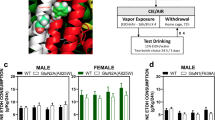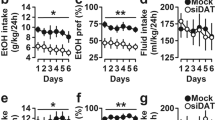Abstract
Ethanol sensitivity may play a role in the risk of developing alcoholism. The role of 5-HT3 receptors in sensitivity to ethanol was assessed in mice over-expressing the 5-HT3 receptor in the forebrain. Sleep time and ED50 for loss of righting reflex (LRR) were used to assess the effect of a high dose of ethanol in transgenic versus non-transgenic mice. The ED50 for ethanol-induced increase in open field activity was used to measure differences in sensitivity to low dose ethanol. The ED50 for ethanol-induced increase in activity was 41% lower in the 5-HT3 receptor over-expressing transgenic mice compared to non-transgenic mice. However, 5-HT3 receptor over-expressing mice did not differ from control mice in ethanol metabolism, ED50 for LRR, and ethanol sleep time. Over-expression of 5-HT3 receptors in mouse forebrain results in an enhanced sensitivity to the stimulating effects of a low dose of ethanol without altering ethanol sedating effects or ethanol metabolism. These data suggest that 5-HT3 receptors modulate low dose ethanol sensitivity and may explain why, in previous studies, these mice consume less ethanol.
Similar content being viewed by others
Author information
Authors and Affiliations
Additional information
Received: 11 December 1998 / Final version: 24 February 1999
Rights and permissions
About this article
Cite this article
Engel, S., Allan, A. 5-HT3 receptor over-expression enhances ethanol sensitivity in mice. Psychopharmacology 144, 411–415 (1999). https://doi.org/10.1007/s002130051025
Issue Date:
DOI: https://doi.org/10.1007/s002130051025




